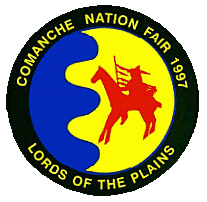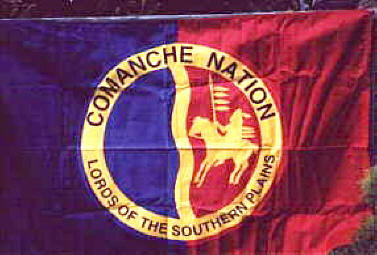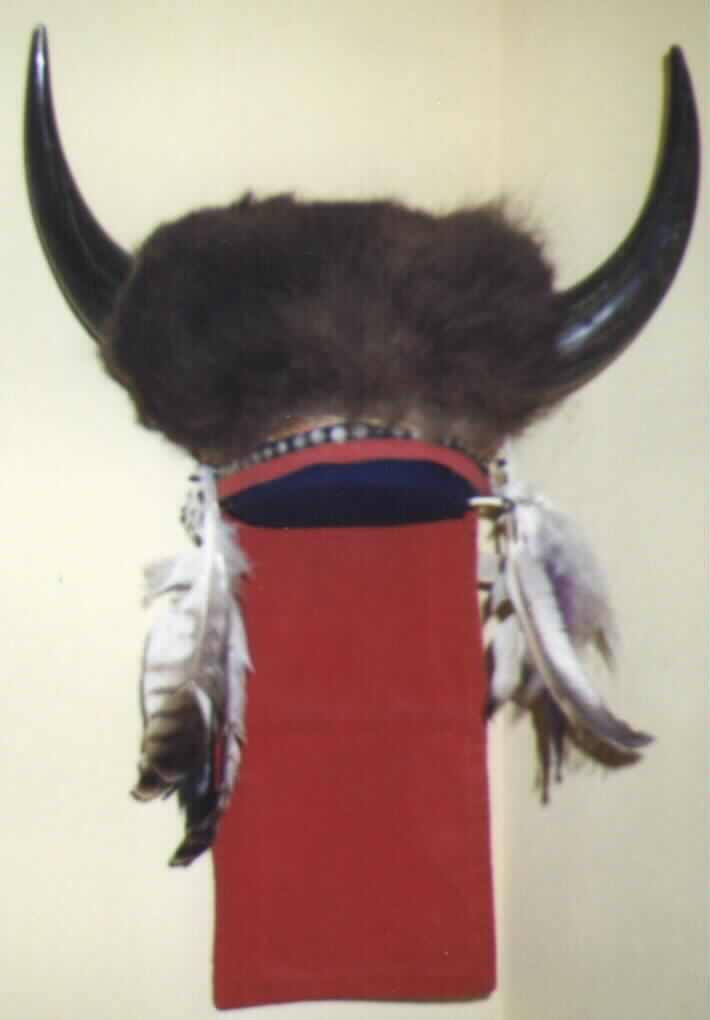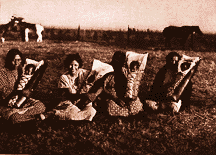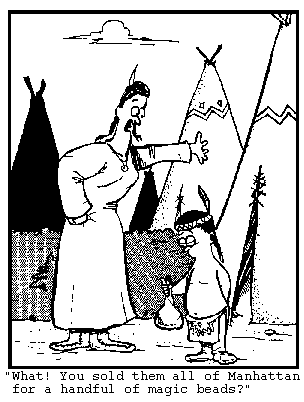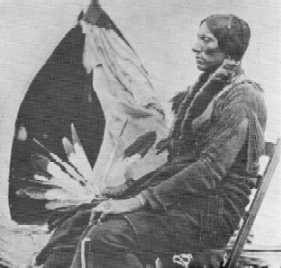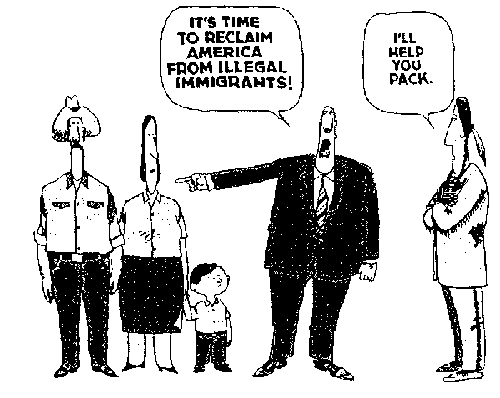|
|||
| The Comanche tribes' nickname from many people was " Lords of the Plains". They were once said to be the most important tribe in the plains states. Most of this had to do with having the largest and best herd of horses of any Indian tribe, and being a very feared warrior. It was also once said that on a horse, a Comanche had no equal. | |||
|
|
|||
| To the right you will see the Comanche flag. The red horsemen on the flag represents what all the Native Americans were called by the European settlers, "The Red-Man". The line that is curved represents a snake moving backwards. Comanche legends are told that the Comanche were known as the "snake people" in the ancient times. The yellow part of the shield represents the brightness of the sun and a state of happiness. Lastly, the blue represents loyalty. |
|
||
|
|
|||
| Before anyone knew that the Comanche existed, they were part of the Shoshoni tribes. Where they lived was near the upper part of the Platte River in Wyoming. When the horse came into the Comanches' lives they went South around 1700, and others followed around 1830. For the next 50 years the Comanche were located between the Platte River and the Arkansas River. This was in Eastern Colorado and Western Kansas. In the 1740's they began crossing the Arkansas River and settled on the Llano Estacada land. It was located from Western Oklahoma across the Texas Panhandle into New Mexico. The area they controlled, they named "Comancheria". The Comanches are currently located in Oklahoma or the Platte River, Wyoming. | |||
|
|
|||
|
|
The Comanches' dress was similar to other tribes with some exceptions. The men dressed in deerskin pants and shirts. Women wore dresses make of deerskin and knee boots with beads. Men wore deerskin moccasins or warriors would wear light blue riding boots that usually went up to the hip. Clothing was usually always deerskin but if they did have clothe, they preferred blue or scarlet. When warriors would wear a war bonnet, it would usually be made from a buffalo scalp with horns. To your right is a picture of one of these war bonnets. These would protect the warrior from head injury. | ||
| As for the appearance of a Comanche you could usually describe them as being shorter. Warriors would wear their hair long, parted in the middle, and braided on the sides. As for the women, they wore their hair short. To the right is a dress worn by a woman in the Comanche tribe. |
|
||
|
|
|||
|
|
Leadership was always male, but it was not based on hereditary. If you had a lot of "puha" or war honors, medicine power, or if you were generous you could be chief or as they called it, "parabio". The Comanche lacked in laws and rules. The power of a parabio could vary. They were however strict when a wife was adulterous. She would be punished by either being killed or having her nose cut off. The also wouldn't let women pick their husbands. | ||
|
|
|||
| The Comanche do have a couple chiefs that stand out. one of the most important leaders or parabio, of the Comanche was Ten Bears. Ten Bears was the main person that spoke at the Medicine Lodge Treaty signing. He lived from 1792-1872. Here are some exerts from one of his famous speeches.... | |||
|
This is a picture of the famous Comanche chief Ten Bears. |
|
||
| ..."My people have never first drawn a bow or fired a gun against the whites. There has been trouble on the line between us and my young men have danced the war dance, but it was not begun by us...They have made sorrow come into our camps, and we went out like buffalo bulls when the cows are attacked. When we found them we killed them and their scalps hang in our lodges. The Comanches are not weak and blind like pups of a dog when seven sleeps old. They are strong and foresighted like grown horses. We took their road and went on it. The white women cried, and our women laughed...I want no blood upon my land to stain the grass. I want it clean and pure and I wish it so that all who go through among my people may find peace when they come in, and leave it when they out". - Ten Bears | |||
| Another great chief of the Comanches was Quanah Parker. Quanah Parker is most likely the best known Comanche Chief to the Americans. This is probably because of his mother's story. Cynthia Ann Parker, his mother, was captured by the Comanches and later married a Comanche and had a son. She was later taken back by Texas rangers, but Quanah escaped to be with his people. Quanah's name means fragrant or sweet smelling. He grew to become a very great warrior. He and the Comanches fought the Texas rangers and the U.S. Army many times. Another interesting fact is that he and Theodore Roosevelt were friends. They used to hunt wolves together. Quanah did many great things for his people. He lived from 1850-1911. |
This is a picture of Quanah Parker. |
||
|
|
|||
| When you think of Comanche, you think of horse. They are believed to be the first Native Americans to use and breed the horse so well. Comanches even supplied Americans with their horses during gold rushes. For this reason the Comanche were probably the most important tribe of the Great Plains. Their name is somewhat similar to the picture image of a "wild indian" which, some say, is deserved having remembered that they robbed almost every horse and mule in new Mexico and Northern Mexico. The Comanche also put a good dent in the available stock in Texas. Plains horse culture grew and when George Catlin was a guest of the Comanche he stated: "I am ready without hesitation, to pronounce the Comanches the most extraordinary horsemen that I have seen yet in all my travels, and I doubt very much whether any people in the world can surpass them." He also stated this very detailed description of a Comanche warrior..."he is able to drop his body upon the side of his horse at the instant he is passing, effectually screened from his enemies' weapons as he lies in a horizontal position behind the body of his horse, with his heel hanging over the horse's back; by which he has the power of throwing himself up again, and changing to the other side of the horse if necessary. In this wonderful condition he will hang whilst his horse is at fullest speed carrying with him his bow and his shield, and also his long lance of fourteen feet in length all or either of which he will use upon his enemy as he passes; raising and throwing his arrows over the horse's back or with equal ease and equal success under the horse's neck." They were able to do this because they would drop their weight into a short hair-braid under the horse's neck. | |||
| They also learned how to breed horses. By doing this they gained very large herds. Most of the time after the 1800's the Comanches had herds of horses other tribes could only dream about. Because the Comanches stole so many horses, in 1775 the Spanish Governor of New Mexico was complaining that the Comanche raiders had stolen so many herds of horses in New Mexico, he did not have enough to re-supply. | |||
|
|
|||
| Comanche raids were said to be legendary. They could not only cover enormous ground, but could also strike hundreds of miles from their starting point. War parties usually traveled at night following separate paths, but would all be going to the same place. War paint was black and was usually painted in two big black stripes across their face. They had a war hoop that sounded like a high school cheer, Rah-Rah-Rah. After the raid they would split up into even smaller groups and head home. A lot of the Comanche even wore some of their stolen booty : Stovepipe hats, women's corsets, and so on making them look like a circus. People would have found this funny if they weren't so dangerous. They would usually kill men prisoners at the scene, but women and children were brought back to their village. The women were usually raped, enslaved, and kept for the sale of slaves or ransom. Children were either sold as slaves or often adopted and raised as a Comanche. They could care-less who was natural-born and adopted. | |||
| They also wanted to protect their horses, so they would often put on leather armor and shields for the warrior and his horse. This typed of war forced the Spanish, Texans, and Americans to cope with a new style of mounted warfare. In the 1840's the Texas rangers organized to fight the Comanche. The U.S. Army in 1835 had to stop fighting the Comanche because of lack of funds, so a mix of rough frontier ranchers and farmers took over. This is when the Texas Rangers vs. the Comanche wars began. One famous battle is Bushy Creek. | |||
|
|
|||
| If a warrior died his horse was usually killed also. The dead were buried in a shallow trench. Comanche religion was basic. The parabio would have vision quests and it centered around these. They would have a pipe smoking ceremony on special occasions. They had their own version of the Sun Dance, and when the Ghost Dance swept across the country they did not participate. | |||
|
|
|||
|
|
The Comanche are often described as "wild indians." Actually they were just great warriors and horsemen protecting their land. Like Ten Bears once said..."There has been trouble on the line between us, and my young men have danced the war dance; but it was not begun by us." The Comanche have been a huge part of horse culture and have contributed greatly to history. They are a truly unique tribe. | ||
|
Whitney Fox 8th American History Rossville Jr. High Plains History Project 2004 |
|||

